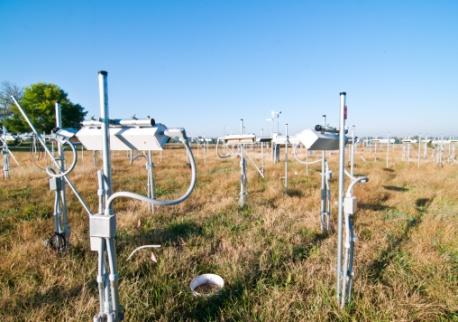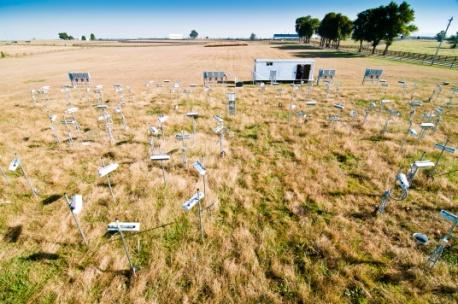![]() Waste to Worth home | More proceedings….
Waste to Worth home | More proceedings….
Why Study Climate Change and Pastures?
Pastures cover more than 14 million hectares in the eastern half of the United States and support grazing animal and hay production while also contributing to the maintenance of overall environmental quality and ecosystem services. Climate change is likely to alter the function of these ecosystems. This manipulative field experiment evaluated the effect of warming and additional precipitation on forage production and quality.
What Did We Do?
We initiated a multi-factor climate change study, elevating air temperature (+3º C) and increasing growing season precipitation (+30% of long-term mean annual), in a central Kentucky pasture managed for hay production. Treatments began in May 2009 and have run continuously since. We measured the effects of warming and increased precipitation on pasture production, forage quality metrics, and for endophyte-infected tall fescue, ergot alkaloid concentrations.

Photo of the UK Forage Climate Change Experiment in Lexington, KY. |
What Have We Learned?
Effects of warming and increased precipitation on total yearly pasture production varied depending on the year of study; however, climate treatments never reduced production below that of the ambient control. Effects on forage quality metrics were relatively subtle. For endophyte-infected tall fescue, warming increased both ergovaline and ergovalinine concentrations (+40% of that in control ambient plots) throughout the study. These results indicate that central Kentucky pastures may be relatively resilient to future climate change; however, warming induced increases in ergot alkaloid concentrations in endophyte-infected tall fescue suggests that animal issues associated with fescue toxicosis are likely to be exacerbated under future climatic conditions.

Aerial photo of the UK Forage Climate Change Experiment. |
Future Plans
We will continue this study for one more growing season and then destructively harvest it (in Fall 2013).
Authors
Rebecca McCulley, Associate Professor, Dept of Plant and Soil Sciences, University of Kentucky, rebecca.mcculley@uky.edu
Jim Nelson – Research Scientist, Dept. of Plant & Soil Sciences, University of Kentucky
A. Elizabeth Carlisle – Research Technician, Dept. of Plant & Soil Sciences, University of Kentucky
Additional Information
http://www.ca.uky.edu/pss/index.php?p=997
Acknowledgements
We acknowledge the support of DOE-NICCR grant DE-FC02-06ER64156, UK’s College of Agriculture Research Office, the USDA-ARS Forage Animal and Production Research Unit (specific cooperative agreement 58-6440-7-135), the Kentucky Agricultural Experiment Station (KY006045), and numerous undergraduates and graduate students who have helped collect the data presented herein.
The authors are solely responsible for the content of these proceedings. The technical information does not necessarily reflect the official position of the sponsoring agencies or institutions represented by planning committee members, and inclusion and distribution herein does not constitute an endorsement of views expressed by the same. Printed materials included herein are not refereed publications. Citations should appear as follows. EXAMPLE: Authors. 2013. Title of presentation. Waste to Worth: Spreading Science and Solutions. Denver, CO. April 1-5, 2013. URL of this page. Accessed on: today’s date.

